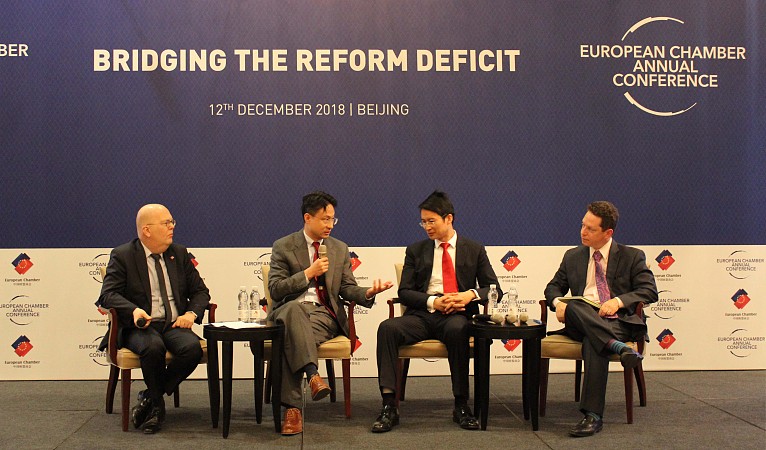China’s Innovation Drive: Top-down and Bottom-up Go back »
2019-01-10 | All chapters

From left to right:
Mats Harborn, President, European Union Chamber of Commerce in China (moderator)
Wang Su, Corporate Vice President, JD.COM
Winston Ma, CEO, China Silkroad Investment & Development
Scott Kennedy, Deputy Director of the Freeman Chair in China Studies, Centre for Strategic and International Studies
Scott Kennedy, Deputy Director of the Freeman Chair in China Studies at the Centre for Strategic and International Studies, delivered a presentation on the findings of a recent report published by his organisation. He noted that examples of heavy top-down innovation drives routinely indicated inefficient use of resources. Commercial aircraft development, for example, has been a major priority of the government that has received extensive support over the last three decades with little to show for it. Meanwhile, innovation driven from the bottom up like mobile payments and bike sharing have thrived, indicating that the current approach from the government may not be the best one.
In the midst of a major spurt of innovation, China is rapidly approaching the cutting edge in a variety of sectors. However, this is occurring in a context of both extensive top-down drives from the government alongside a market composed of fast-moving private firms of all sizes that are exploring new horizons. Panelists discussed how the interplay between these two forces have led to a highly innovative market that has thrived either because of or in spite of either approach.
Speakers examined sectors of success in the Chinese innovation sphere to perform a comparison between industries to see what lessons could be derived. The industries brought out in the China Manufacturing 2025 plan, for example, proved to be a source of debate, with one speaker calling the heavy support extended by the government, often to state-owned enterprises, a strategy that has created a “fat tech dragon” that is woefully inefficient. In areas where market players have thrived in pushing innovation forward, one speaker noted that the government commonly gives sufficient space to firms to experiment in, only to then begin to regulate the activity once a market is established. Bike-sharing, they argued, is a perfect example of an almost anarchic approach leading to tighter regulation.
The discussion then shifted to the role that the government should play in driving innovation. A general consensus formed around the role of government in things like basic research to do the early work that companies cannot afford to take risks on. After that, however, disagreement was held over further involvement by the state. Speakers examined the role that the government plays in the US, for example, in aerospace, where companies often straddle military and civilian roles, meaning that they can apply lessons from one side to the other and take ideas funded by the military and apply them to civilian use. China, on the other hand, has always drawn a very stark line between military and civilian firms, meaning that innovation driven either by government funding and needs or by market driven private demand manage to be applied in both cases. The conversation then ended on a note of concern about how technological balkanisation between the US and China could seriously impact the innovation of private companies caught in the middle of the two markets.
See the other two panels:
Headwinds or Tailwinds? Deepening Reform in the Trade War Era, the first panel, examined the effect that the US-China trade conflict and rising tensions elsewhere are having on China’s economic reform and opening up agenda.
Economic Outlook and the Impact for Business, the third panel, brought together top economists to consider the probable macro trends that we can expect to see in 2019 and what that will mean for business, trade conflict, and growth.